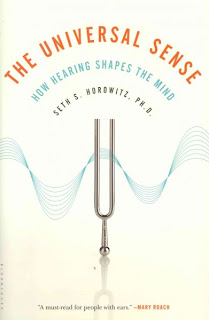Reviews by the Reference Department of the Bristol Public Library, Bristol, Virginia/Tennessee.
Friday, April 12, 2013
Nevermore: Neuroscience
The Nevermore Book Club picks ran to non-fiction this week and to neuroscience in particular. Library Director Jud Barry is very intrigued with The Universal Sense: How Hearing Shapes the Mind by Seth Horowitz. Horowitz is both a musician and a neuroscientist who specializes in the study of sound and how it affects us. One of the first things to note is that ears are individual, and the way we hear is determined in part by the precise shape of the ear and its parts. Sound can alter moods, attract or repel, and influence our health.
Jud read aloud a section on how to use sound as a merchandising tool to entice someone to buy a particular product. Another interesting tidbit involved how certain frequencies repeated over and over can cause someone to more or less lose the ability to think rationally. Remember the last time the smoke detector went off accidentally in your house? Remember how desperate you were to make it SHUT UP? Do you think you could have solved a math problem before cutting the darn thing off? Jud commented that while others talk around him, he finds it very difficult to follow any one conversation. There’s simply too much other noise, just like the smoke detector.
Jud said that while the book can get a bit technical at times, for the most part it’s very approachable and readable.
Another member had just finished Oliver Sacks’ new book Hallucinations. The neurologist continues his exploration of unusual mental states and conditions with this collection of essays examining people who sense things that the rest of us do not. One may see something that isn’t there, or still feel pain from an amputated limb, or hear voices. Sack looks at the science behind these occurrences, using actual cases to illustrate his stories. Our reader said she had trouble buying into some of the ideas, and didn’t believe that these things could exist as reality for some people. Sacks is known for his articles and essays about subjects such as autism, Tourette Syndrome, sleeping sickness, and other atypical disorders. The movie Awakenings was based on one of his books.
Finally, another member had picked up the anniversary edition of Drawing on the Right Side of the Brain by Betty Edwards. The book was first published in 1979 and was an instant classic. Edwards contended that the different sides of the brain process things differently, with the right side handling the visual and emotional, and the left managing verbal and analytical. The book has a number of exercises to train the artist to use the right side of the brain. We’ll be getting a report next time as to whether or not he found it effective.
The Nevermore Book Club meets every Tuesday at 11 AM in the Frances E. Kegley Meeting Room. Members bring whatever books they’re reading to share with the group. No registration is necessary. Doughnuts are provided by the fabulous Blackbird Bakery and coffee is courtesy of the library.
Subscribe to:
Post Comments (Atom)




No comments:
Post a Comment